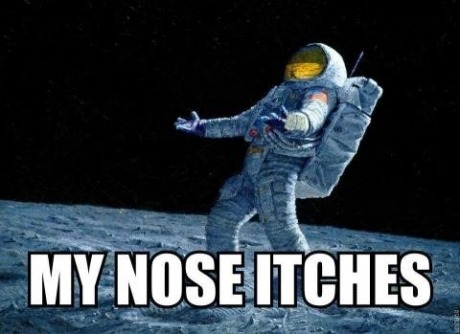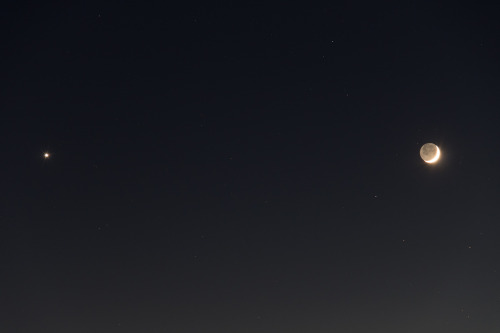Space-cute - Space Appreciation

More Posts from Space-cute and Others

Bonneville Salt Flats, Utah (Canon Rebel T6, Rokinon 14mm f/2.8, 25 seconds, ISO 1600). I-80 traffic created the light trails. by Woosh_Cecil
★☆★ SPACE ★☆★


*** & *** by Lincoln Harrison









Happy 90th birthday to Buzz Aldrin.

I saved this meme in 2013, and a full decade later I learned that its real title is “Is Anyone Out There?”
It was painted by Alan Bean, the fourth astronaut to walk on the moon.
And it still makes a darn good meme. (Even if astronauts do have bits of Velcro in their helmets for exactly this reason.)

Ring Galaxy AM 0644-741

Dueling Bands in the Night : What are these two bands in the sky? The more commonly seen band is the one on the right and is the central band of our Milky Way galaxy. Our Sun orbits in the disk of this spiral galaxy, so that from inside, this disk appears as a band of comparable brightness all the way around the sky. The Milky Way band can also be seen all year – if out away from city lights. The less commonly seem band, on the left, is zodiacal light – sunlight reflected from dust orbiting the Sun in our Solar System. Zodiacal light is brightest near the Sun and so is best seen just before sunrise or just after sunset. On some evenings in the north, particularly during the months of March and April, this ribbon of zodiacal light can appear quite prominent after sunset. It was determined only this century that zodiacal dust was mostly expelled by comets that have passed near Jupiter. Only on certain times of the year will the two bands be seen side by side, in parts of the sky, like this. The featured image, including the Andromeda galaxy and a meteor, was captured in late January over a frozen lake in Kanding, Sichuan, China. via NASA

Vela Supernova Remnant Mosaic
The plane of our Milky Way Galaxy runs through this complex and beautiful skyscape. Seen toward colorful stars near the northwestern edge of the constellation Vela (the Sails), the 16 degree wide, 200 frame mosaic is centered on the glowing filaments of the Vela Supernova Remnant, the expanding debris cloud from the death explosion of a massive star. Light from the supernova explosion that created the Vela remnant reached Earth about 11,000 years ago. In addition to the shocked filaments of glowing gas, the cosmic catastrophe also left behind an incredibly dense, rotating stellar core, the Vela Pulsar. Some 800 light-years distant, the Vela remnant is likely embedded in a larger and older supernova remnant, the Gum Nebula. Objects identified in this broad mosaic include emission and reflection nebulae, star clusters, and the remarkable Pencil Nebula. Credit: Robert Gendler, Roberto Colombari, Digitized Sky Survey (POSS II)

Milky Way Over El Pescadero, Mexico


Moon and Venus by frankastro
-
 ousa-90-n7 liked this · 2 months ago
ousa-90-n7 liked this · 2 months ago -
 emams liked this · 1 year ago
emams liked this · 1 year ago -
 missrupy liked this · 3 years ago
missrupy liked this · 3 years ago -
 ificouldhavetimeinabottle reblogged this · 3 years ago
ificouldhavetimeinabottle reblogged this · 3 years ago -
 rrue-world reblogged this · 3 years ago
rrue-world reblogged this · 3 years ago -
 ethereal-angelfaerie reblogged this · 3 years ago
ethereal-angelfaerie reblogged this · 3 years ago -
 closetoyou1970 reblogged this · 3 years ago
closetoyou1970 reblogged this · 3 years ago -
 spring-heeled-jack642 reblogged this · 3 years ago
spring-heeled-jack642 reblogged this · 3 years ago -
 ohfallingstar reblogged this · 3 years ago
ohfallingstar reblogged this · 3 years ago -
 lotussands reblogged this · 3 years ago
lotussands reblogged this · 3 years ago -
 lotussands liked this · 3 years ago
lotussands liked this · 3 years ago -
 kivulimi liked this · 3 years ago
kivulimi liked this · 3 years ago -
 erinalyse16 reblogged this · 3 years ago
erinalyse16 reblogged this · 3 years ago -
 fancy-club-hot-tub liked this · 3 years ago
fancy-club-hot-tub liked this · 3 years ago -
 zenzabuloz reblogged this · 3 years ago
zenzabuloz reblogged this · 3 years ago -
 of-mists-and-void reblogged this · 3 years ago
of-mists-and-void reblogged this · 3 years ago -
 elle-vee-one reblogged this · 3 years ago
elle-vee-one reblogged this · 3 years ago -
 theodorflorin liked this · 3 years ago
theodorflorin liked this · 3 years ago -
 lady-rian liked this · 3 years ago
lady-rian liked this · 3 years ago -
 sleepinsidemysoul reblogged this · 3 years ago
sleepinsidemysoul reblogged this · 3 years ago -
 allison-w0nderland liked this · 3 years ago
allison-w0nderland liked this · 3 years ago -
 don-alhussain liked this · 3 years ago
don-alhussain liked this · 3 years ago -
 konohoshis reblogged this · 3 years ago
konohoshis reblogged this · 3 years ago -
 pineappleofprosperity liked this · 3 years ago
pineappleofprosperity liked this · 3 years ago -
 meunomeed reblogged this · 3 years ago
meunomeed reblogged this · 3 years ago -
 meunomeed liked this · 3 years ago
meunomeed liked this · 3 years ago -
 blondeinblack reblogged this · 3 years ago
blondeinblack reblogged this · 3 years ago -
 persanelegantmilkshakezombi-blog liked this · 3 years ago
persanelegantmilkshakezombi-blog liked this · 3 years ago -
 stephaknee reblogged this · 3 years ago
stephaknee reblogged this · 3 years ago -
 blondeinblack liked this · 3 years ago
blondeinblack liked this · 3 years ago -
 theenclave1 liked this · 3 years ago
theenclave1 liked this · 3 years ago -
 aaymm liked this · 3 years ago
aaymm liked this · 3 years ago -
 marjinalbigboy liked this · 3 years ago
marjinalbigboy liked this · 3 years ago -
 samesoupjustreheated77 liked this · 3 years ago
samesoupjustreheated77 liked this · 3 years ago
